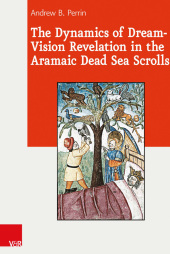 Neuerscheinungen 2015Stand: 2020-02-01 |
Schnellsuche
ISBN/Stichwort/Autor
|
Herderstraße 10
10625 Berlin
Tel.: 030 315 714 16
Fax 030 315 714 14
info@buchspektrum.de |

Andrew B. Perrin
The Dynamics of Dream-Vision Revelation in the Aramaic Dead Sea Scrolls
2015. 312 S. with 7 tables. 2.4 cm
Verlag/Jahr: VANDENHOECK & RUPRECHT 2015
ISBN: 3-525-55094-4 (3525550944)
Neue ISBN: 978-3-525-55094-6 (9783525550946)
Preis und Lieferzeit: Bitte klicken
This study maps out the compositional patterns and exegetical, priestly, and historiographical applications of dream-visions in a constellation of twenty-nine Second Temple period writings among the Aramaic Dead Sea Scrolls.
Among the predominantly Hebrew collection of the Dead Sea Scrolls are twenty-nine compositions penned in Aramaic. While such Aramaic writings were received at Qumran, these materials likely originated in times before, and locales beyond, the Qumran community. In view of their unknown past and provenance, this volume contributes to the ongoing debate over whether the Aramaic texts are a cohesive corpus or accidental anthology. Paramount among the literary topoi that hint at an inherent unity in the group is the pervasive usage of the dream-vision in a constellation of at least twenty writings. Andrew B. Perrin demonstrates that the literary convention of the dream-vision was deployed using a shared linguistic stock to introduce a closely defined set of concerns. Part One maps out the major compositional patterns of dream-vision episodes across the collection. Special attention is paid to recurring literary-philological features (e.g., motifs, images, phrases, and idioms), which suggest that pairs or clusters of texts are affiliated intertextually, tradition-historically, or originated in closely related scribal circles. Part Two articulates three predominant concerns advanced or addressed by dream-vision revelation. The authors of the Aramaic texts strategically employed dream-visions (i) for scriptural exegesis of the antediluvian/patriarchal traditions, (ii) to endorse particular understandings of the origins and functions of the priesthood, and (iii) as an ex eventu historiographical mechanism for revealing aspects or all of world history. These findings are shown to give fresh perspective on issues of revelatory discourses in Second Temple Judaism, the origins and evolution of apocalyptic literature, the ancient context of the book of Daniel, and the social location of the Aramaic Dead Sea Scrolls.
Andrew B. Perrin contributes to the ongoing debate over whether the Aramaic texts among the Dead Sea Scrolls are a cohesive corpus or accidental anthology. Paramount among the literary topoi that hint at an inherent unity is the pervasive usage of the dream-vision in a constellation of at least twenty writings.
The author demonstrates that the literary convention of the dream-vision was employed for scriptural exegesis, to endorse particular understandings of the origins and functions of the priesthood, and as an ex eventu historiographical mechanism for revealing aspects or all of world history.
Perrin, Andrew B.
Andrew B. Perrin is Assistant Professor of Religious Studies and Co-Director of the Dead Sea Scrolls Institute at Trinity Western University in Langley, British Columbia, Canada


